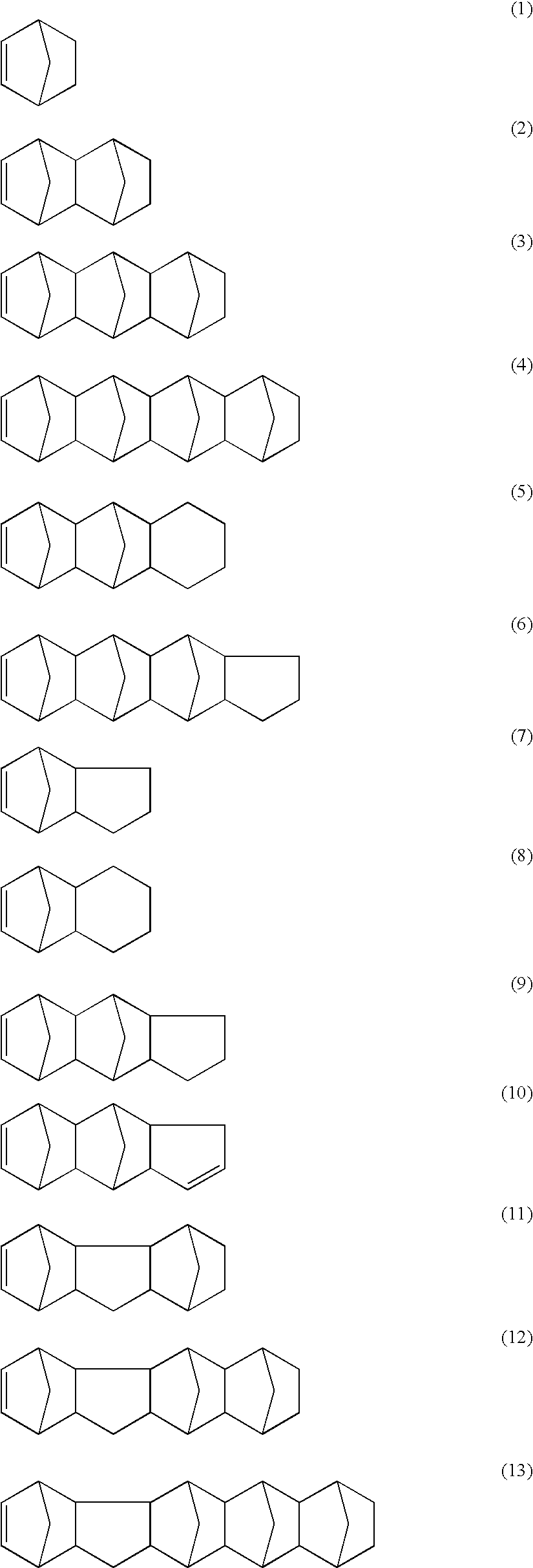Modified cycloolefin copolymer, process for producing the same, and use of the polymer
- Summary
- Abstract
- Description
- Claims
- Application Information
AI Technical Summary
Benefits of technology
Problems solved by technology
Method used
Image
Examples
example 1
[0077] In an inactive atmosphere and with stirring, 10 parts by weight of maleic anhydride and 50 parts by weight of toluene were added to 100 parts by weight of a base polymer being a cycloolefin copolymer with ethylene chains, to give a solution. While the solution was heated at 95° C. and stirred, 50 parts by weight of a toluene solution containing 10 parts by weight of benzoyl peroxide dissolved therein was added dropwise. Subsequently, the mixture was thermally aged at 100° C. with stirring for 3 hours and was cooled to room temperature. Thus, a resin solution with 52 wt % nonvolatile components was obtained. The modified cycloolefin copolymer obtained had (RI) of 3.23 and (UV) of 3.03. The distribution correlation coefficient (DR) was determined to be 0.04.
example 2
[0078] Likewise in Example 1, in an inactive atmosphere and with stirring, 20 parts by weight of maleic anhydride and 50 parts by weight of toluene were added to 100 parts by weight of a base polymer being a cycloolefin copolymer with ethylene chains, to give a solution. While the solution was heated at 95° C. and stirred, 50 parts by weight of a toluene solution containing 25 parts by weight of benzoyl peroxide dissolved therein was added dropwise. Subsequently, the mixture was thermally aged at 100° C. with stirring for 3 hours and was cooled to room temperature. Thus, a resin solution with 54 wt % nonvolatile components was obtained. The modified cycloolefin copolymer obtained had (RI) of 3.07 and (UV) of 2.87. The distribution correlation coefficient (DR) was determined to be 0.04.
example 3
[0079] Likewise in Example 1, in an inactive atmosphere and with stirring, 15 parts by weight of 2-methylallyl glycidyl ether as chemical material having nucleophilic reactive groups and 50 parts by weight of toluene were added to 100 parts by weight of a base polymer being a cycloolefin copolymer with ethylene chains, to give a solution. While the solution was heated at 95° C. and stirred, 50 parts by weight of a toluene solution containing 2 parts by weight of benzoyl peroxide dissolved therein was added dropwise. Subsequently, the mixture was thermally aged at 100° C. with stirring for 3 hours and was cooled to room temperature. Thus, a resin solution with 53 wt % nonvolatile components was obtained. The modified cycloolefin copolymer obtained had (RI) of 3.17 and (UV) of 2.95. The distribution correlation coefficient (DR) was determined to be 0.05.
PUM
| Property | Measurement | Unit |
|---|---|---|
| Temperature | aaaaa | aaaaa |
| Temperature | aaaaa | aaaaa |
| Fraction | aaaaa | aaaaa |
Abstract
Description
Claims
Application Information
 Login to View More
Login to View More - R&D
- Intellectual Property
- Life Sciences
- Materials
- Tech Scout
- Unparalleled Data Quality
- Higher Quality Content
- 60% Fewer Hallucinations
Browse by: Latest US Patents, China's latest patents, Technical Efficacy Thesaurus, Application Domain, Technology Topic, Popular Technical Reports.
© 2025 PatSnap. All rights reserved.Legal|Privacy policy|Modern Slavery Act Transparency Statement|Sitemap|About US| Contact US: help@patsnap.com

